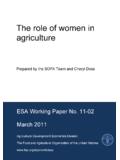Transcription of A CRITICAL REVIEW OF CHILD CUSTODY …
1 A CRITICAL REVIEW OF CHILD . CUSTODY evaluation REPORTS. James N. Bow and Francella A. Quinnell This study examined 52 CHILD CUSTODY reports drafted by doctoral-levelpsychologists from across the United States to determine (a) the nature, scope, and quality of the evaluationprocess as reflected in report content; (b)the degree to which practice as documented in reports is congruentwith practice as describedby survey data, and (c) the man- ner in which evaluationresults are communicatedto the general, the findingssuggest that evaluation proce- dures identified in reports are consistent with those described in past survey research and with CUSTODY guidelines. Evaluationstend to be court ordered,comprehensive,and well written. Ways in which reports can be improved were identified. One of the most controversial areas of forensic psychology is CHILD CUSTODY practice. Numerous authors have criticized the quality of evaluationscompleted in this area (Melton, Petrila, Poythress, & Slobogin, 1997;Melton, Weithorn, & Slobogin, 1985; O'Donohue &.)
2 Bradley, 1999; Turkat, 1993). Complaints have included the lack of empirical methods, the inappropriateuse of psychological tests, the improper use and interpretation of data, and the lack of usefulness to the court. O'Donohue & Bradley (1999) even called for a moratorium on such evaluations. In 1994,two professional organizationspromulgatedchild CUSTODY guidelines to promote proficiency in this area. These guidelines, the then-Association of Family and Conciliation Courts' (AFCC s) Courts Model Standards of Practice for CHILD CUSTODY Evaluations and the American Psychological Association's (ApAs) Guidelines for CHILD CUSTODY Evalua- tions in Divorce Proceedings addressed the purpose of the evaluation , preparatory and training issues, and procedural steps. Adherence to these guidelines and the quality of cus- tody evaluations and reports continue to be areas of debate. Ensuring high-quality CHILD CUSTODY evaluationsand reports is important for a number of reasons. First, the focus of the evaluation is on the best interests of the CHILD (AFCC, 1994.
3 APA, 1994). As noted by Woody (2000), there is a strong societal need to safeguard the well-beingof children; the evaluation should thus fulfill evaluators'legal duty to protect chil- dren's best interests. Second, the stress of divorce often results in anguish and tension for family members (Hodges, 1991).This is particularly true in disputedcontested divorces. It is essential, therefore, that the evaluation process minimize the probability of iatrogenic harm (Ackerman & Ackerman, 1996),that is, evaluators'precipitating or aggravatinginjury to the parties because of their attitudes, actions, or comments. If the evaluatormaintains neutrality, listens to all parties, uses the same standard procedures, and handledreports data in a sensi- tive manner, it is hoped this goal can be attained. Third, the conclusions and recommenda- tions made by evaluators significantlyimpact families. It is imperativefor evaluatorsto con- Authors'Note: The authors wish to acknowledge Joyce Chapman and Arlene Richardsonfor their secretarial assis- tance during this project.
4 Correspondence concerning this article should be addressed to James N. Bow, , Director of Psychology,Hawthorn Center. 18471 Haggerty Road. Northville,Michigan 48167;e-mail: FAMILY COURT REVIEW , Vol. 0 . 2 , April 2002 164-176. 0 2002 Sage Publications 164. Bow,Quinnell I CRITIQUE OF CUSTODY REPORTS 165. sider developmental issues, strengths, and weaknesses of the parents and current divorce/. CUSTODY research in the evaluation process. Fourth, CUSTODY disputes deal with a variety of emotionally charged issues. Consequently, it is important for evaluators to maintain an objective stance, to understand transference and countertransferenceissues, and to adhere to professional practice parameters. Otherwise, they may risk malpractice suits or board ethical complaints. Last, CUSTODY evaluators infrequently testify in court (Bow & Quinnell, 2001a; Melton et al., 1985).The expert's report is usually taken at face value and is not sub- jected to cross-examination, which further supports the need for high-quality professional work.
5 A variety of approaches have been used to assess the quality of CHILD CUSTODY evaluations. For example, a number of these studies have surveyed the practices and procedures of mental health professionals conducting such evaluations (Ackerman & Ackerman, 1997; Bow &. Quinnell, 2001a; Keilin & Bloom, 1986;LaFortune & Carpenter, 1998). Findings indicate that significant improvements have occurred over the past 15 years. Evaluations have become more comprehensiveand sophisticated,incorporatingdata from multiple collection sources and the application of CRITICAL decision-makingskills. Evaluators have also become more aware of ethical and risk-management issues. Survey research has also focused on the legal community's beliefs and attitudes about CHILD CUSTODY evaluations (Bow & Quinnell, 2001b; LaFortune, 1997). Both judges and attorneys preferred court-ordered evaluations and favored psychologists as mental health experts in such matters. Objectivity was noted to be paramount in the evaluation process.
6 Both studies indicated a need for improvement in CUSTODY reports. In particular, BOWand Quinnell (2001b) found that judges and attorneys from Michigan favored a more CHILD - focused report that addressed statutory best interests of the CHILD criteria and provided rec- ommendations for CUSTODY and visitation. Also, timely completion of the evaluatiodreport ( , 5 to 6 weeks) was highly desired. These survey studies have some definite limitations in their ability to determine the qual- ity of CHILD CUSTODY work. First, survey research relies on retrospectiveestimates, which may not actually reflect frequency and usage rates of different CUSTODY practices and procedures. Second, the methods and procedures reported as being used by evaluators may vary greatly from their actual practices and procedures. Third, survey research does not reflect how data are integrated and presented in a report format. An actual REVIEW of CHILD CUSTODY evaluation reports is a more accurate indicator of evalu- ation practices and procedures.
7 However, this type of research is complicated by confidenti- ality issues, willingness of mental health professionals to share their work, and lack of readily accessible reports from private practitioners. These factors have deterred needed research in this CHILD CUSTODY area. This study sought to overcome such obstacles and undertook the REVIEW of actual CUSTODY evaluation reports. Reports best reflect CHILD CUSTODY practices and procedures and allow accurate assessment of how data and findings are presented in a report . Because procedures used in CHILD CUSTODY evaluations vary among mental health professionals, it was decided that this study would focus only on doctoral-level psychologists. 166 FAMLY COURT REVIEW . METHOD. IDENTIFICATIONOF PARTICIPANTS. Names of potential participants were obtained from the fol1,owing sources: an Internet search, public access referral lists from the American Board of Forensic Psychology and the Michigan Society of Forensic Psychology, Friend of the Court (FOC) nominations, and the first author's knowledge of evaluators through conferences, workshops, and articleshooks.
8 In addition, psychology members of the Internet CHILD CUSTODY Evaluators'listserver group were contacted. Overall, 265 potential participants were identified. SELECTION PROCEDURE. Each potential participant was sent a letter explaining the nature and purpose of the study and describing the specific requirement for participation, that is, submission of a typical CHILD CUSTODY evaluation report , with all identifying information omitted, to the researchers. Prospective participants were also informed that all information would be confidential and data would be analyzed and reported on a group basis only. Those interested in participating were asked to return an enclosed preaddressed stamped postcard and were then sent a packet of materials including cover letter, informational consent form, evaluator's demographic information sheet, $5 to cover copying cost, and stamped return envelope. Of the 265 persons contacted, 78 returned the postcard and were sent the packet of materials as described above.
9 Approximately 1 month after forwarding the packet, a reminder postcard was sent request- ing return of the completed study documents. Fifty-six individuals returned the requested information; however, only 52 met the study criteria-for example, psychologists perform- ing CHILD CUSTODY evaluations. Four individuals were from other disciplines ( , social worker, licensed counselor). DATA COLLECTION. Data were collected from the demographicinformation sheet and the CHILD CUSTODY evalu- ation report returned by study participants. Demographic information provided included age, gender, primary work state, educationalbackground, years of experience, and CHILD cus- tody experience. To objectively evaluate the CHILD CUSTODY report , a detailed check sheet was developed to collect relevant data to be used for analysis, including the format of the report and areas covered, procedures used in the evaluation process, types of psychological tests used with children and adults, structure of parent- CHILD observations, handling of collateral data sources, and types of recommendations made.
10 PARTICIPANT DEMOGRAPHICS. The average age of the participants was years (SD= 6.!20),with a range from 32 to 72. Males constituted 62% of the sample. All participants were doctoral-levelpsychologists, with 87% 's., 11% 's., and 2% 's. The vast majority had a major in clinical psychology (71%),followed by counseling psychology (15%), school psychology (4%), and 10%other ( , forensic psychology, developmental psychology, and chldfamily psychol- Bow, Quinnell / CRlTIQUE OF CUSTODY REPORTS 167. ogy). Fourteen percent of participants were diplomates of the American Board of Forensic Psychology. All participants lived in the United States; 23 states were represented. The aver- age length of clinical experience was years (SD= ), with (SD = ). of CHILD CUSTODY average, they devoted 40% of their practices to CHILD CUSTODY work and conducted 22 evaluationsper year. In total, they had completed an average of 215. CHILD CUSTODY evaluations (median = 130), with a range from 22 to 1,500.





